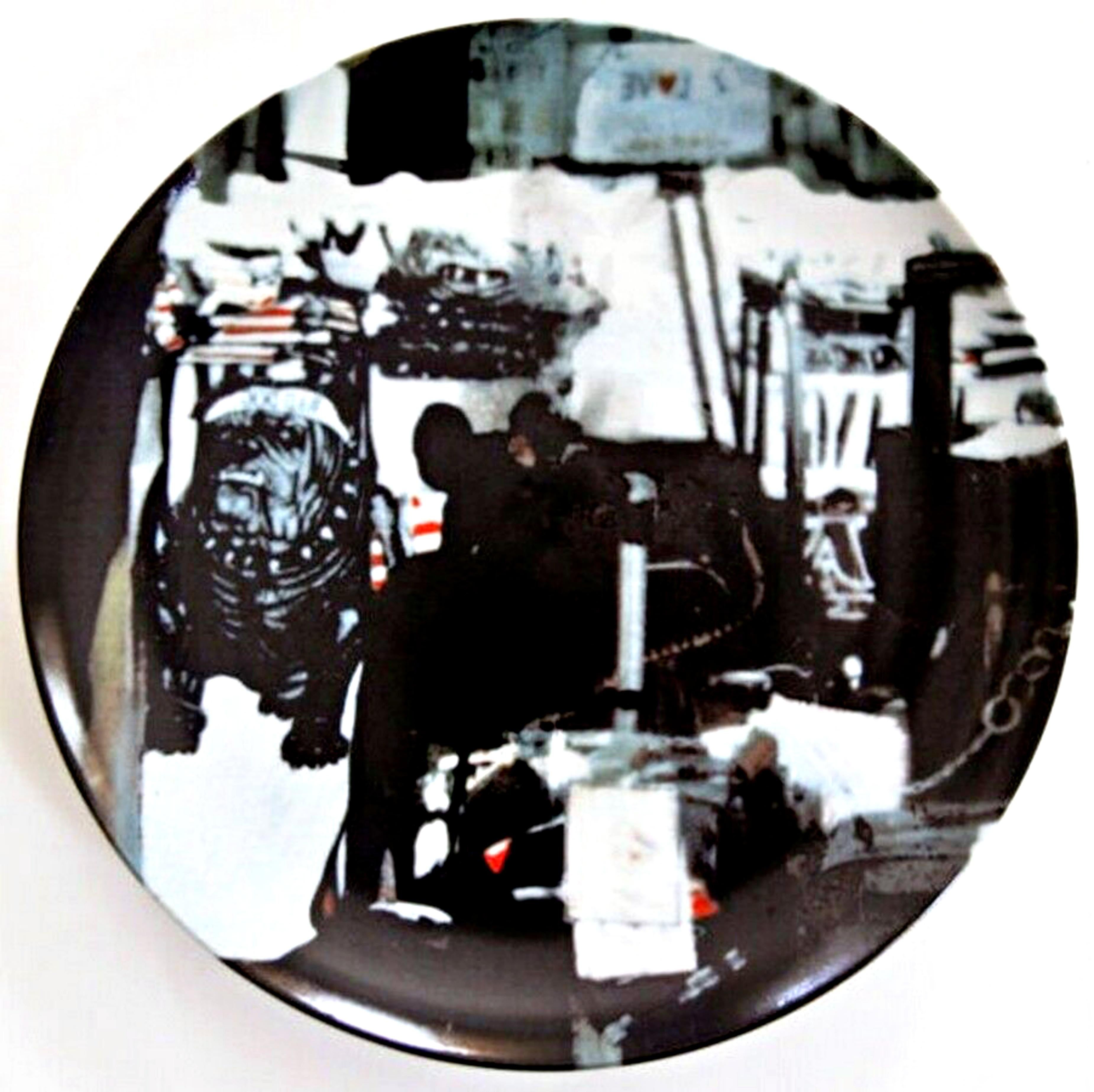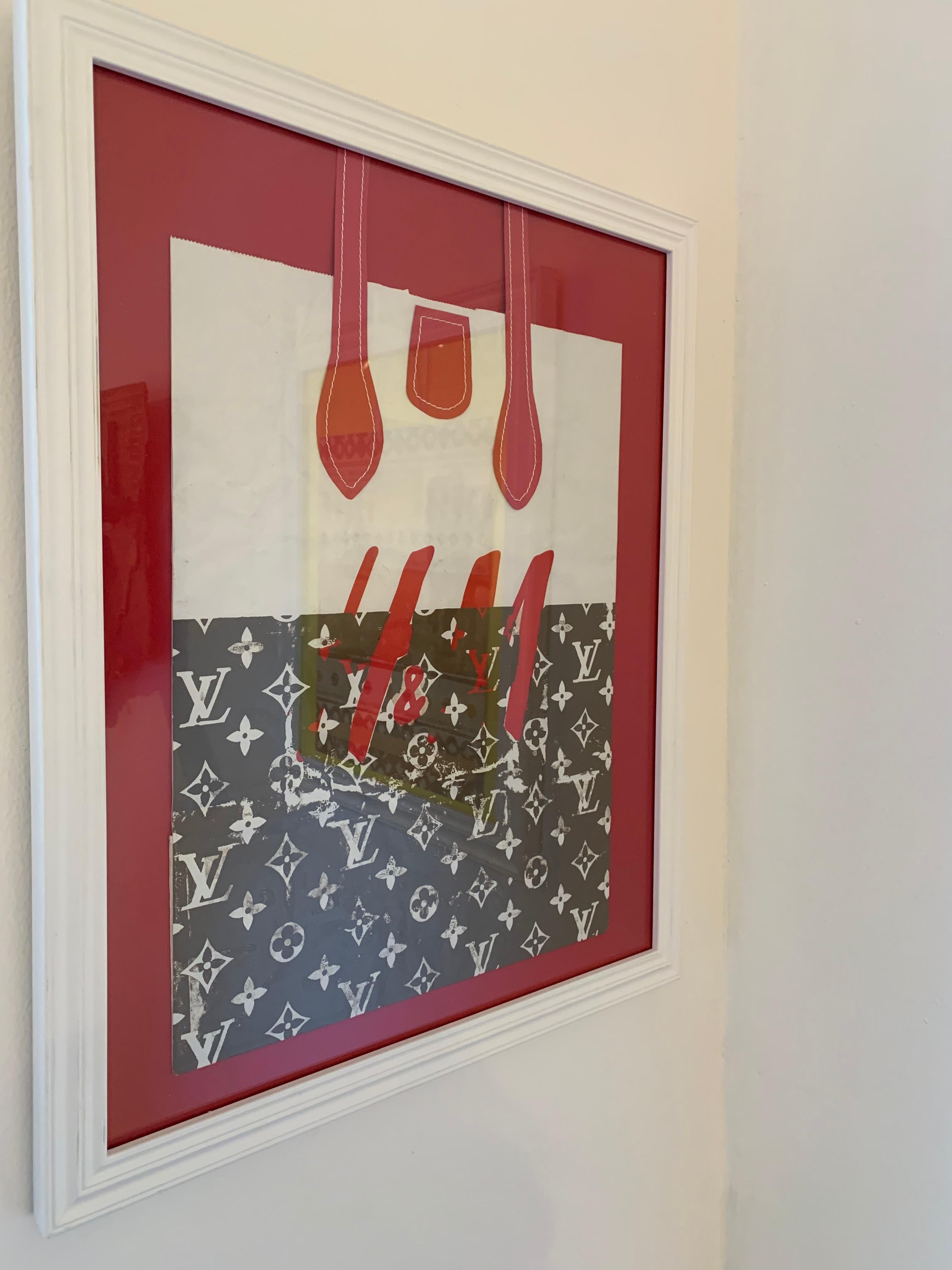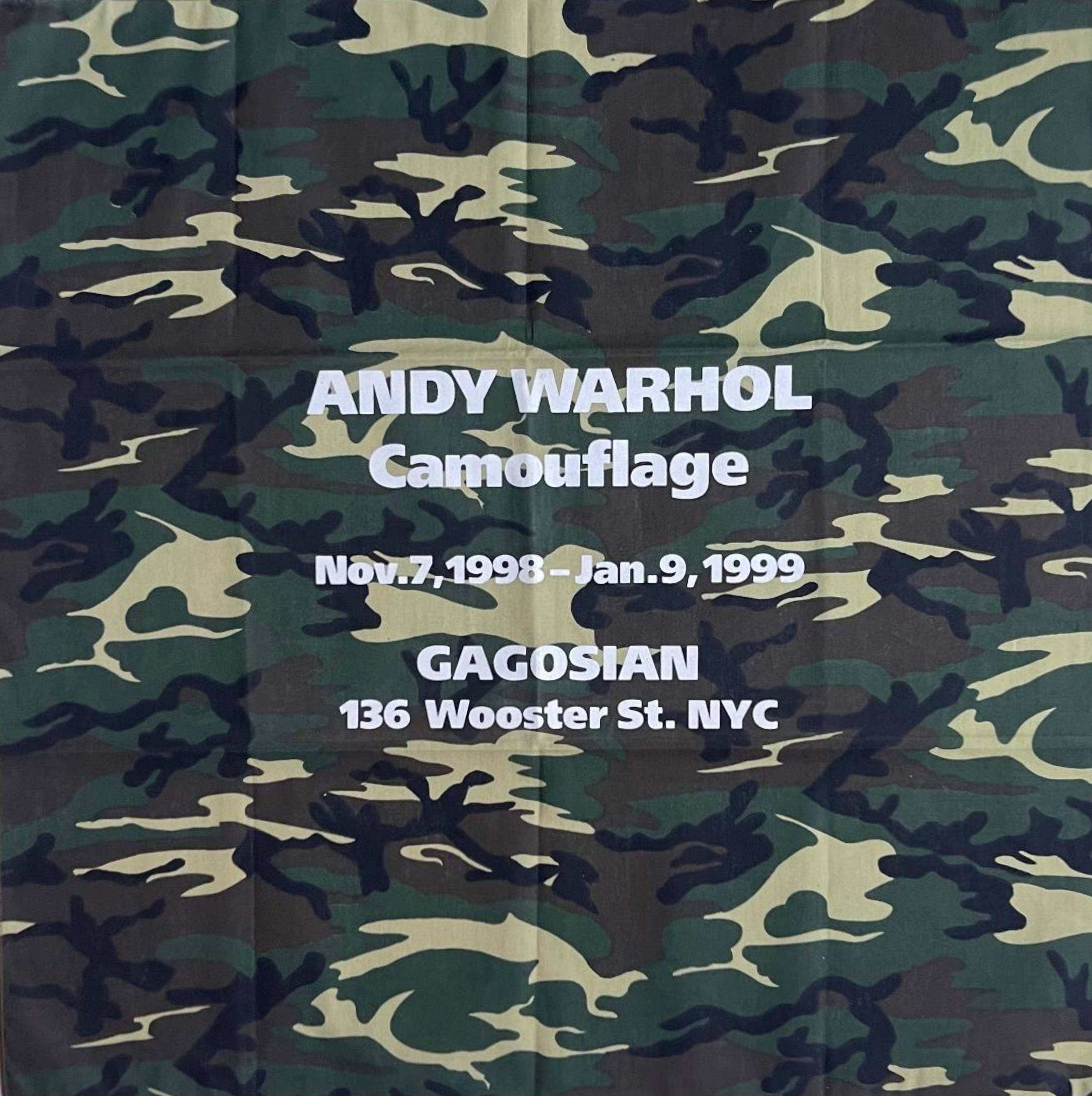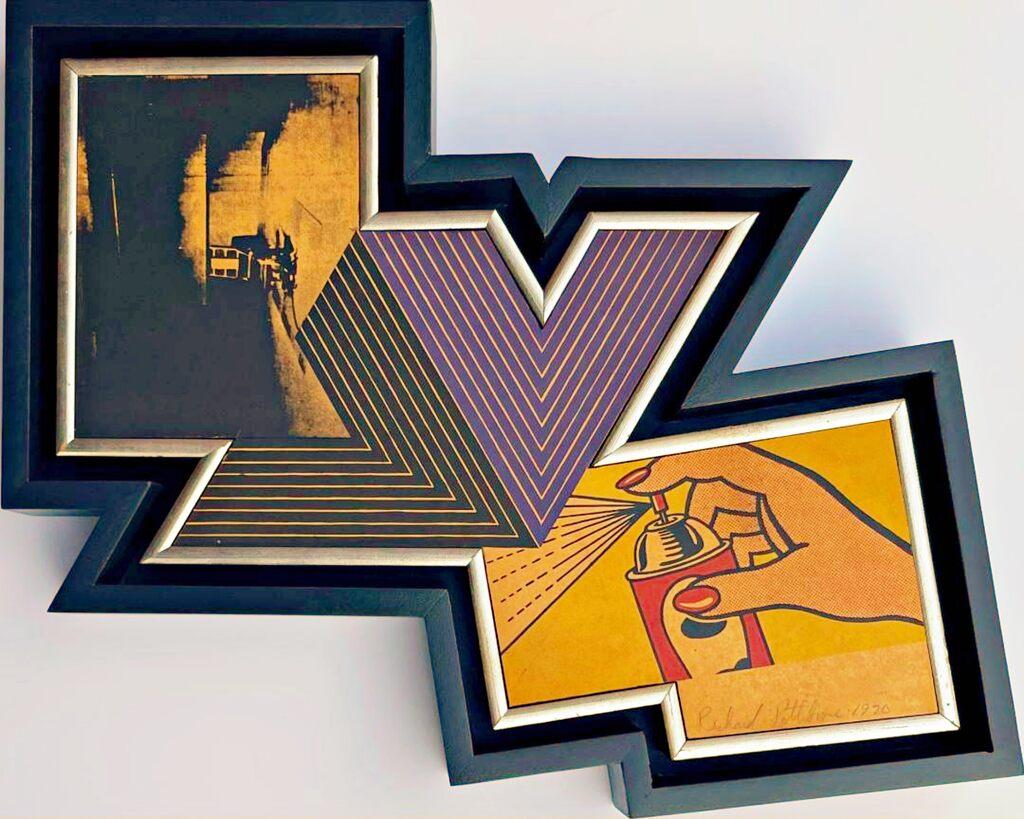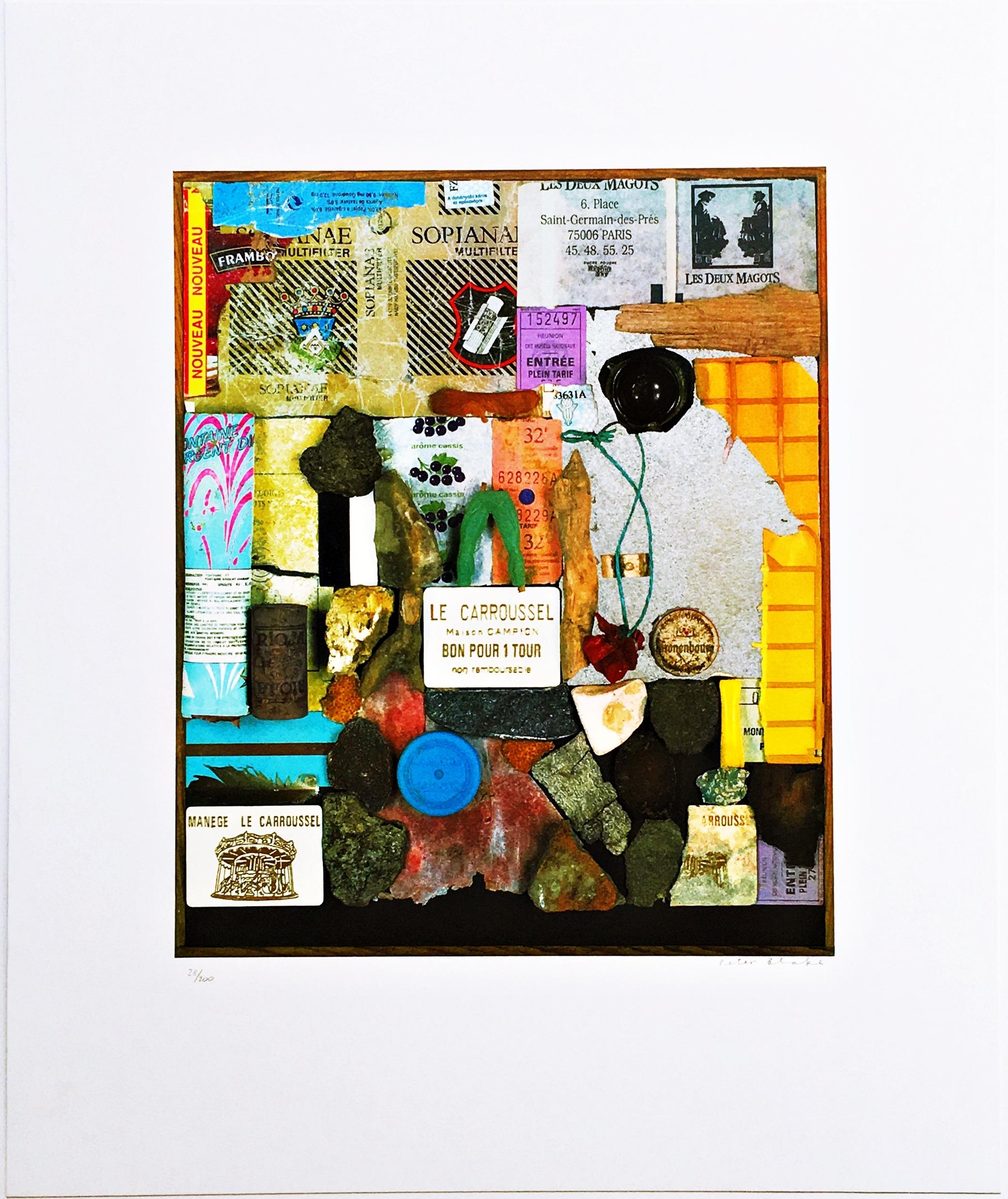Items Similar to Plate for Rigatoni Alla Catanese - Da Ciro - New York, NY,
Want more images or videos?
Request additional images or videos from the seller
1 of 6
Mark KostabiPlate for Rigatoni Alla Catanese - Da Ciro - New York, NY,2001
2001
About the Item
Mark Kostabi
Plate for Rigatoni Alla Catanese - Da Ciro - New York, NY, 2001
Silkscreen on ceramic plate; Microwave and Dishwasher Safe
10 1/5 in diameter
Artist signature fired into the plate on the underside and numbered from an edition of 510.
Edition 36/510
Makes a wonderful gift! This beautiful, whimsical limited edition, signed and numbered bowl/plate was handmade in southern Italy by master artisans near Vietri sul Mare, was designed by American artist Mark Kostabi. In 2000, Buon Ricordo America, Inc. commissioned famous American artists to design plates for their flagship US restaurants. In 2000-1, Kostabi designed the present work for the NY Italian restaurant, Da Ciro for a once-only charitable fundraiser. (Da Ciro was a popular restaurant on Lexington Avenue in Manhattan that is now closed; though today there is another restaurant called Da Ciro in Brooklyn.) Kostabi's design depicts one of the restaurant's signature dishes, Rigatoni Alla Catanese This plate is a real collector's item -- and difficult to find as it was created in a limited edition and never mass marketed. The artist's signature is fired into the plate on the verso (back) and numbered 36 from the limited edition of 500. After the 9/11 attacks in New York, production stopped on the plates and the edition was not completed.
These plates were made in conjunction with Buon Ricordo America, Inc., an offshoot of the Italian restaurant union, Boun Ricordo (Unione Ristoranti del Buon Ricordo). The plates capture the essence of each restaurant’s local specialty, and the decoration is embellished with references to the restaurant, its local territory and products. The rim of each plate bears the name of the restaurant the dish and the town or village it is in.
Going plate was made from local clay from a quarry in Ogliara, a few kilometres from Vietri. After biscuit firing they are coated and decorated by hand by skilled craftsmen using a carbon “dusting” technique similar to that once used for Renaissance fresco painting. Once the plates were decorated they are glazed and fired for a second time to fix their vivid colors. In the early 2000s, Buon Ricordo America, Inc. collaborated with some of America's most prominent artists to make a series of plates for iconic restaurants throughout the United States.
The verso (back) of the plate reads as follows:
"Limited edition designed by the artist to benefit charitable organizations dedicated to bring hope and help children in need around the world."
"The artist does not derive any income from the sale of this plate."
"Microwave, oven and dishwasher safe."
"Printed by Decoritalia"
"Made in Italy"
No 36/510
- Creator:Mark Kostabi (1960, American)
- Creation Year:2001
- Dimensions:Height: 10.2 in (25.91 cm)Diameter: 10.2 in (25.91 cm)
- Medium:
- Movement & Style:
- Period:
- Condition:
- Gallery Location:New York, NY
- Reference Number:1stDibs: LU1745211313632
Mark Kostabi
Mark Kostabi became a leading figure in New York City's East Village art scene during the mid-1980s, along with other luminaries such as Keith Haring.
Kostabi's work is in the permanent collections of some of the world's most prominent institutions, including the Museum of Modern Art, the Metropolitan Museum of Art, the Guggenheim Museum and the National Gallery in Washington, D.C., among many others.
Find authentic Mark Kostabi prints, paintings and other art on 1stDibs.
About the Seller
5.0
Platinum Seller
These expertly vetted sellers are 1stDibs' most experienced sellers and are rated highest by our customers.
Established in 2007
1stDibs seller since 2022
292 sales on 1stDibs
Typical response time: 1 hour
- ShippingRetrieving quote...Ships From: New York, NY
- Return PolicyA return for this item may be initiated within 1 day of delivery.
More From This SellerView All
- Untitled Limited Edition Porcelain Plate (Guggenheim Museum)By Robert RauschenbergLocated in New York, NYRobert Rauschenberg Untitled Limited Edition Porcelain Plate (Guggenheim Museum), 1997 Porcelain Plate (Limited Edition Exclusively for Guggenheim) 10 2/5 in diameter Signed in plate...Category
1990s Pop Art Abstract Prints
MaterialsPorcelain, Screen
- Gagosian Gallery Announcement Scarf/Bandana, Andy Warhol Camouflage ExhibitionBy Andy WarholLocated in New York, NYAfter Andy Warhol Camouflage Exhibition Gagosian Gallery Announcement Scarf/Bandana, 1998 Silkscreened letters on cotton cloth fabric 21 1/2 × 21 1/2 inches Unframed Collectible souvenir scarf/bandana issued as an invitation to attend the opening reception on November 7, 1998 of the ANDY WARHOL Camouflage Exhibition which ran through January 9, 1999 at Gagosian Gallery downtown on Wooster Street...Category
1990s Pop Art Mixed Media
MaterialsCotton, Screen
- The Appropriation piece: Andy Warhol, Frank Stella, Roy Lichtenstein Unique var.By Richard PettiboneLocated in New York, NYRichard Pettibone The Appropriation Print Andy Warhol, Frank Stella, Roy Lichtenstein, 1970 Silkscreen in colors on masonite board (unique variant on sculpted board) Hand-signed by artist, Signed and dated on the front (see close up image) Bespoke frame Included This is a rare example of Pettibone's iconic Appropriation Print, as it's silkscreened and sculpted on masonite board rather than paper, giving it a different background hue, and enabling it work to be framed so uniquely. The Appropriation print is one of the most coveted prints Pettibone ever created ; the regular edition is on a full sheet with white background; the present example was silkscreened on board, allowing it to be framed in 3-D. While we do not know how many examples of this graphic work Pettibone created, so far the present work is the only one example we have ever seen on the public market since 1970. (Other editions of The Appropriation Print have been printed on vellum, wove paper and pink and yellow paper.) This 1970 homage to Andy Warhol, Frank Stella and Roy Lichtenstein exemplifies the type of artistic appropriation he was engaging in early on during the height of the Pop Art movement - long before more contemporary artists like Deborah Kass, Louise Lawler, etc. followed suit. This silkscreen was in its original 1970 vintage period frame; a bespoke custom hand cut black wood outer frame was subsequently created especially to house the work, giving it a distinctive sculptural aesthetic. Measurements: Framed 14.5 inches vertical by 18 inches horizontal by 2 inches Work 13 inches vertical by 16.5 inches horizontal Richard Pettibone biography: Richard Pettibone (American, b.1938) is one of the pioneering artists to use appropriation techniques. Pettibone was born in Los Angeles, and first worked with shadow boxes and assemblages, illustrating his interest in craft, construction, and working in miniature scales. In 1964, he created the first of his appropriated pieces, two tiny painted “replicas” of the iconic Campbell’s soup cans by Andy Warhol (American, 1928–1987). By 1965, he had created several “replicas” of paintings by American artists, such as Warhol, Roy Lichtenstein (1923–1997), Ed Ruscha (b.1937), and others, among them some of the biggest names in Pop Art. Pettibone chose to recreate the work of leading avant-garde artists whose careers were often centered on themes of replication themselves, further lending irony to his work. Pettibone also created both miniature and life-sized sculptural works, including an exact copy of Bicycle Wheel by Marcel Duchamp (French, 1887–1968), and in the 1980s, an entire series of sculptures of varying sizes replicating the most famous works of Constantin Brancusi (Romanian, 1876–1957). In more recent years, Pettibone has created paintings based on the covers of poetry books by Ezra Pound, as well as sculptures drawn from the grid compositions of Piet Mondrian (Dutch, 1872–1944). Pettibone straddles the lines of appropriation, Pop, and Conceptual Art, and has received critical attention for decades for the important questions his work raises about authorship, craftsmanship, and the original in art. His work has been exhibited at the Institute for Contemporary Art in Philadelphia, the Museum of Modern Art in New York, the Museum of Contemporary Art in Miami, and the Laguna Art Museum in Laguna Beach, CA. Pettibone is currently based in New York. "I wished I had stuck with the idea of just painting the same painting like the soup can and never painting another painting. When someone wanted one, you would just do another one. Does anybody do that now?" Andy Warhol, 1981 Since the mid-1960s, Richard Pettibone has been making hand-painted, small-scale copies of works by other artists — a practice due to which he is best known as a precursor of appropriation art — and for a decade now, he has been revisiting subjects from across his career. In his latest exhibitions at Castelli Gallery, Pettibone has been showing more of the “same” paintings that had already been part of his 2005–6 museum retrospective,1 and also including “new” subject matter drawn from his usual roster of European modernists and American postwar artists. Art critic Kim Levin laid out some phases of the intricate spectrum from copies to repetitions in her review of the Warhol-de Chirico showdown, a joint exhibition at the heyday of appropriation art in the mid-1980s when Warhol’s appropriations of de Chirico’s work effectively revaluated “the grand old auto-appropriator”. Upon having counted well over a dozen Disquieting Muses by de Chirico, Levin speculated: “Maybe he kept doing them because no one got the point. Maybe he needed the money. Maybe he meant it when he said his technique had improved, and traditional skills were what mattered.” On the other side, Warhol, in her eyes, was the “latter-day exemplar of museless creativity”. To Pettibone, traditional skills certainly still matter, as he practices his contemporary version of museless creativity. He paints the same painting again and again, no matter whether anybody shows an interest in it or not. His work, of course, takes place well outside the historical framework of what Levin aptly referred to as the “modern/postmodern wrestling match”, but neither was this exactly his match to begin with. Pettibone is one of appropriation art’s trailblazers, but his diverse selection of sources removes from his work the critique of the modernist myth of originality most commonly associated with appropriation art in a narrow sense, as we see, for example, in Sherrie Levine’s practice of re-photographing the work of Walker Evans and Edward Weston. In particular, during his photorealist phase of the 1970s, Pettibone’s sources ranged widely across several art-historical periods. His appropriations of the 1980s and 1990s spanned from Picasso etchings and Brancusi sculptures to Shaker furniture and even included Ezra Pound’s poetry. Pettibone has professed outright admiration for his source artists, whose work he shrinks and tweaks to comic effect but, nevertheless, always treats with reverence and care. His response to these artists is primarily on an aesthetic level, owing much to the fact that his process relies on photographs. By the same token, the aesthetic that attracts him is a graphic one that lends itself to reproduction. Painstakingly copying other artists’ work by hand has been a way of making it his own, yet each source is acknowledged in his titles and, occasionally, in captions on white margins that he leaves around the image as an indication that the actual source is a photographic image. The enjoyment he receives in copying is part of the motivation behind doing it, as is the pleasure he receives from actually being with the finished painting — a considerable private dimension of his work. His copies are “handmade readymades” that he meticulously paints in great quantities in his studio upstate in New York; the commitment to manual labor and the time spent at material production has become an increasingly important dimension of his recent work. Pettibone operates at some remove from the contemporary art scene, not only by staying put geographically, but also by refusing to recoup the simulated lack of originality through the creation of a public persona. In so doing, Pettibone takes a real risk. He places himself in opposition to conceptualism, and he is apprehensive of an understanding of art as the mere illustration of an idea. His reading of Marcel Duchamp’s works as beautiful is revealing about Pettibone’s priorities in this respect. When Pettibone, for aesthetic pleasure, paints Duchamp’s Poster...Category
1970s Pop Art Mixed Media
MaterialsMasonite, Pencil, Screen, Mixed Media
- City Center Light OperaBy Gerald LaingLocated in New York, NYGerald Laing City Center Light Opera, 1968 Lime colored Screenprint on die-cut Mylar Hand signed, numbered 6/144 and dated in pencil on the front 25 × 35 inches Unframed Gerald Laing Biography Born in 1936, Gerald Laing attended the Royal Military Academy, Sandhurst 1953-1955 and after a short army career attended St Martin’s School of Art between 1960-1964. After art school, Laing lived in New York for five years and then became artist in residence at Aspen Institute...Category
1960s Pop Art Abstract Prints
MaterialsScreen, Mylar
- A Walk in the Tuileries Gardens Paris (screenprint with silver leaf and glazes)By Peter BlakeLocated in New York, NYPeter Blake A Walk in the Tuileries Gardens, 2004 26 colour Screenprint with Silver leaf and 3 Glazes Hand signed and numbered 28/200 by artist on lower front 30 1/5 × 22 1/2 inches Unframed A Walk Through the Tuileries Gardens is based on a memory of a stroll in Paris distilled through the ephemera he found along the way. ' The legendary Peter Blake, the father of British Pop Art, is renowned for his love of gathering and collecting the ephemera of life, of memories, of dreams and whimsies, sometimes mingled with those of other historical fantasists. Possessions he regards as symbolic of his relationships with his world, carefully questioning the personal significance of each object in this respect. The scraps of tickets, fragments of plastic, driftwood, pebbles and sycamore leaf in A Walk Through the Tuileries gardens are evocative and ephemeral souvenirs, gathered at the time and collated later perhaps with a whiff of romance. His image takes us, in turn, on a stroll down the wide gravel, under the autumnal trees, a lingering taste of saucisson and red wine on our palate and with a sudden impulse to take a turn on the Caroussel. This whimsical Peter Blake print would make a great gift for any Blake fan. The work is matted and unframed as it had been removed from its original frame. Measurements: Board: 30 1/8 x 22 1/2 inches Sheet: 24 x 20 inches Legendary British Pop Art pioneer British Blake was born in 1932, and after his formal training at the Gravesend School of Art, then at the Royal Academy of Art, he broke away from tradition, producing work from 1960 on that would come to define the British Pop Art Movement. He came to be known as the Grandfather of Pop Art, and his art achieved iconic status with his sleeve for The Beatles’ Sgt Pepper’s Lonely Hearts Club Band. Blake’s art draws on imagery from the popular culture of the past and present, as well as from the canon of fine art, thus creating an alternative, more democratic visual aesthetic. He freely mixes the ‘high’ with the ‘low’, ultimately inviting us to see beyond such distinctions. Always playful, and at times irreverent, he sets up the most unlikely juxtapositions across time and space, creating conversations and ‘parties’ to which all are invited. An abiding theme is an investigation, and celebration, of England and Englishness. Collage has always been a hallmark of Blake’s work, allowing him to freely mix found objects and images of people and other artworks; screenprinting, with its use of stencils and layers, lends itself perfectly to this technique, and indeed it was Pop Art that fully realised the potential of screenprinting as a medium for complex replication. More about Peter Blake: Sir Peter Thomas Blake...Category
Early 2000s Pop Art Abstract Prints
MaterialsSilver
- The Daily Arf (Silkscreen and intaglio of man reading a newspaper with his dog)By Red GroomsLocated in New York, NYRed Grooms The Daily Arf, 1974 Embossed Silkscreen and Blind Intaglio Hand signed and numbered: Pencil signed and dated 1974 lower right; pencil numbered from the edition of only 12 ...Category
1970s Pop Art Abstract Prints
MaterialsIntaglio, Screen
You May Also Like
- BagsLocated in Santa Monica, CASilkscreen/Collage on Retail BagsCategory
21st Century and Contemporary Pop Art Mixed Media
MaterialsScreen
- 1963 Pop Art Mixed Media Silkscreen on Pillowcase Neon Colors Stephen AntonakosBy Stephen AntonakosLocated in Surfside, FLDREAM New York City, USA Provenance: Charles Byron Gallery, [1965] Silkscreen on linen pillowcase Hand signed. this is not numbered. (it says on gallery label verso edition of 100, I do not know how many were actually made) This is from an early-1960s series of pillows that married cloth, text, metal (including plumbing pipes and nails) and other found objects. The last pillow in the series incorporated the word “DREAM” in neon letters. Stephen Antonakos (Greek: Στυλιανός Αντωνάκος) born in 1926 in Agios Nikolaos, Laconia, Greece – died in 2013 in New York City. Antonakos moved with his family from Greece to the United States at the age of 4 and was raised in the Brooklyn, New York neighborhood of Bay Ridge. Antonakos' work has been included in several important international exhibitions including Documenta 6 in 1977 in Kassel, Germany and he represented Greece at the Venice Biennale in 1997. Anatonakos’s long career, characterized by his creation of brightly colored light installations. Works like Arrival (2008) and Neon Table #1 (1986) have a kinship with the works of Dan Flavin, and the 1960s Light and Space movement of Southern California that included Larry Bell, Bruce Nauman, and Doug Wheeler...Category
1960s Pop Art Mixed Media
MaterialsFabric, Acrylic
- ST18c-Contemporary , Abstract, Gestual, Street art, Pop art, Modern, GeometricBy Francisco NicolásLocated in London, LondonFlowers VIII, 2019 Edition of 25 Digital pigment print Ultrachrome ink on Fabriano Rosaspina paper. Hand signed by the artist, and certificate of authenticity, (Unframed) His work...Category
2010s Pop Art Abstract Prints
MaterialsArchival Pigment
- ST1C18-Contemporary , Abstract, Gestual, Street art, Pop art, Modern, GeometricBy Francisco NicolásLocated in London, LondonEdition of 25 Digital pigment print Ultrachrome ink on Fabriano Rosaspina paper. Hand signed by the artist, and certificate of authenticity, (Unframed) His work has been shown in...Category
2010s Pop Art Abstract Prints
MaterialsArchival Pigment
- flower22-Contemporary , Abstract, Gestual, Street art, art, Modern, GeometricBy Francisco NicolásLocated in London, LondonRoses III, 2019 Edition of 25 Digital pigment print Ultrachrome ink on Fabriano Rosaspina paper. Hand signed by the artist, and certificate of authenticity, (Unframed) His work ha...Category
2010s Pop Art Abstract Prints
MaterialsArchival Pigment
- ST1AC76-Contemporary , Abstract, Gestual, Street art, Pop art, Modern, GeometricBy Francisco NicolásLocated in London, LondonEdition of 25 Digital pigment print Ultrachrome ink on Fabriano Rosaspina paper. Hand signed by the artist, and certificate of authenticity, (Unframed) His work has been shown in...Category
2010s Pop Art Abstract Prints
MaterialsArchival Pigment
